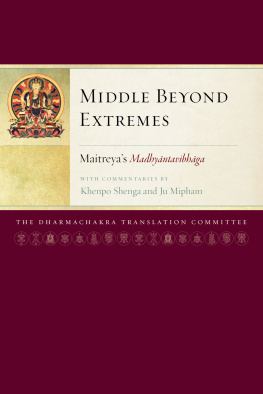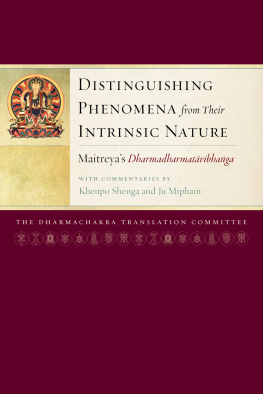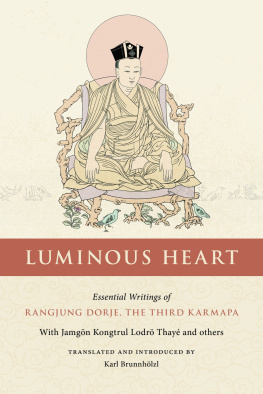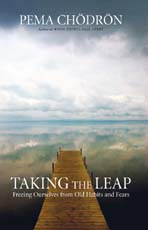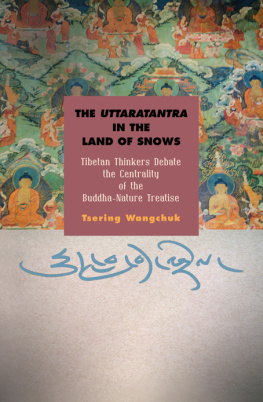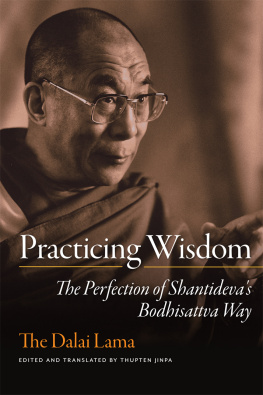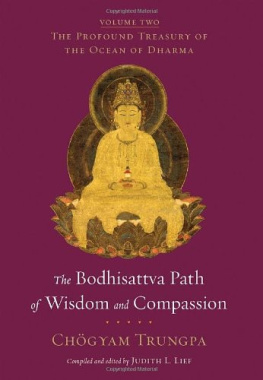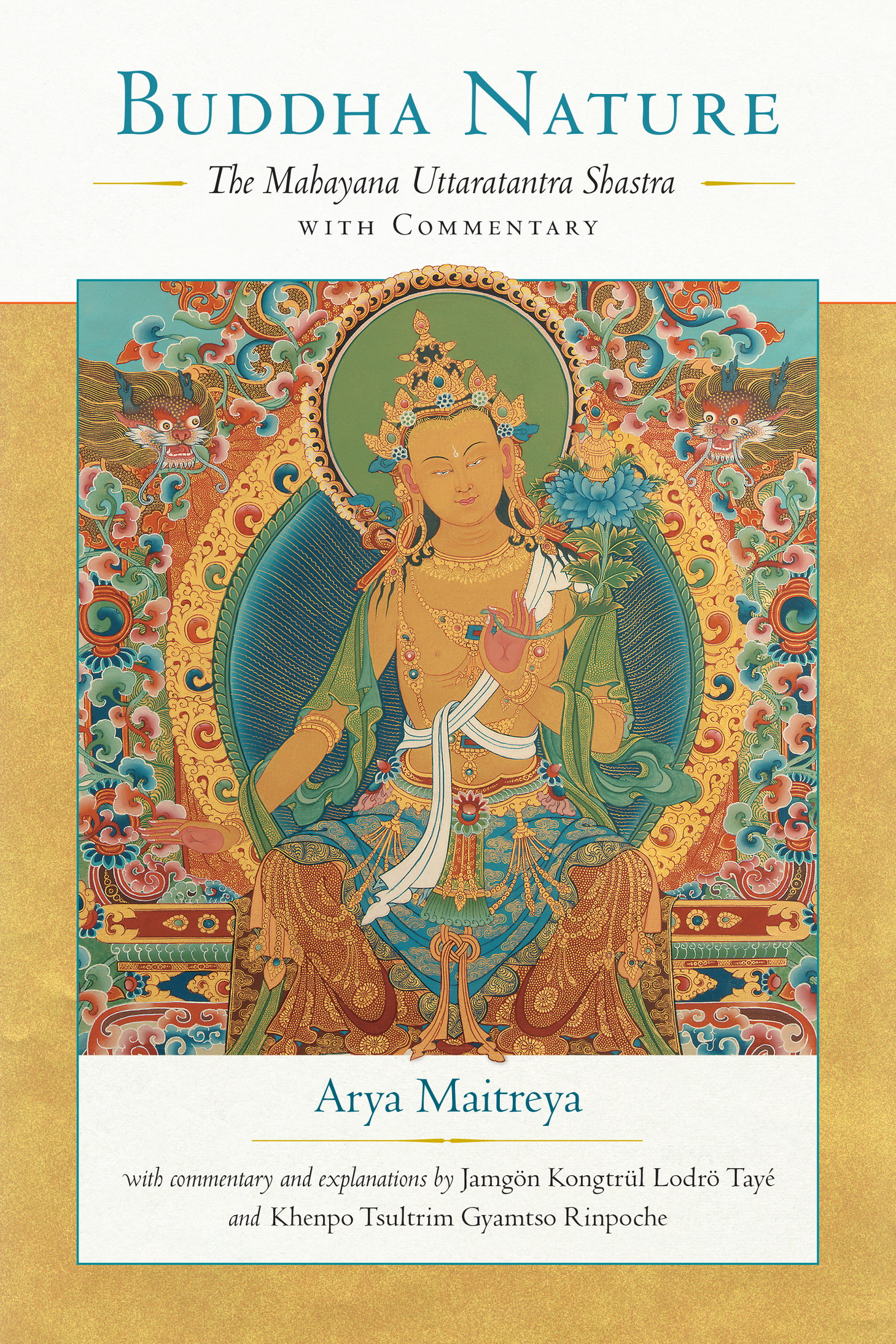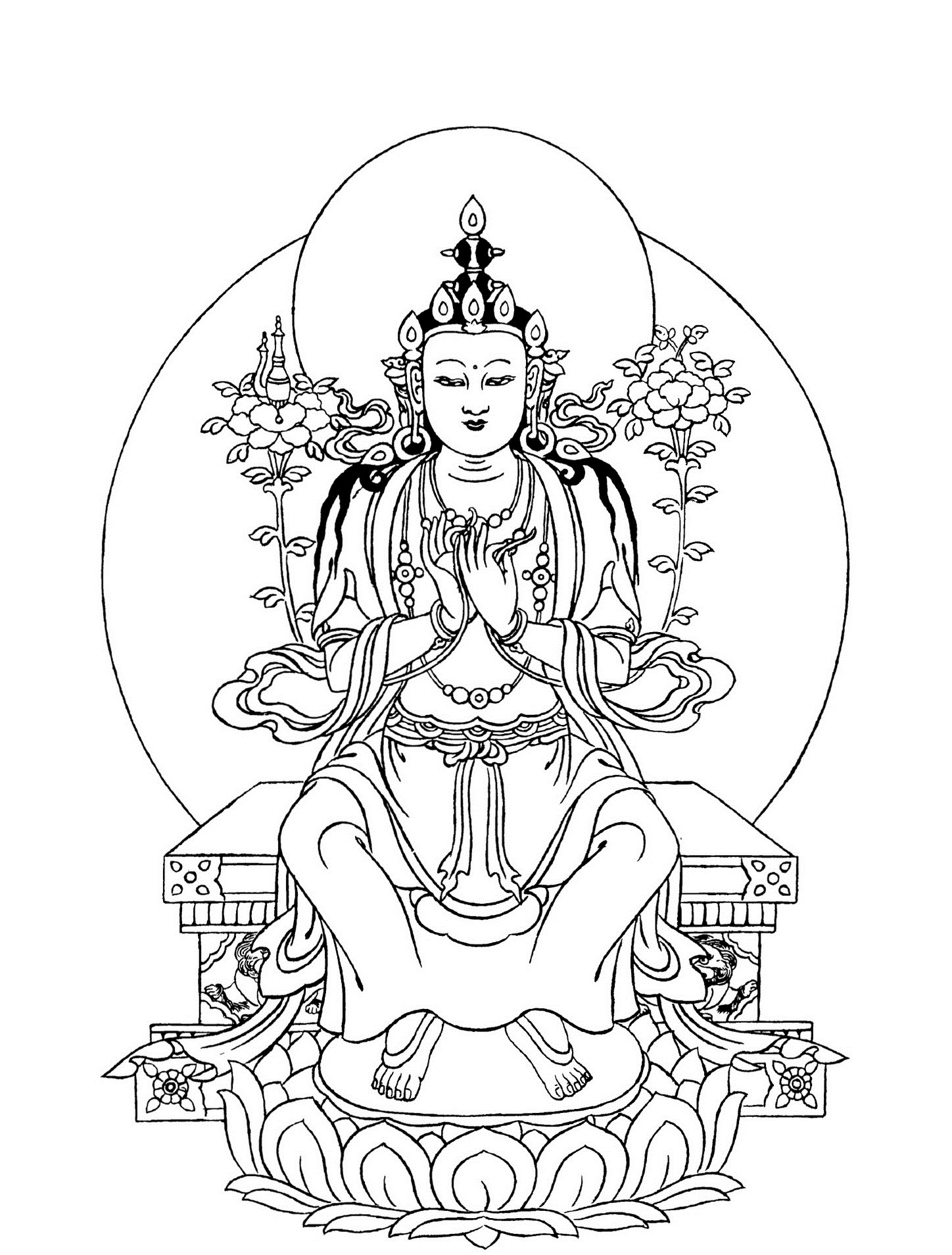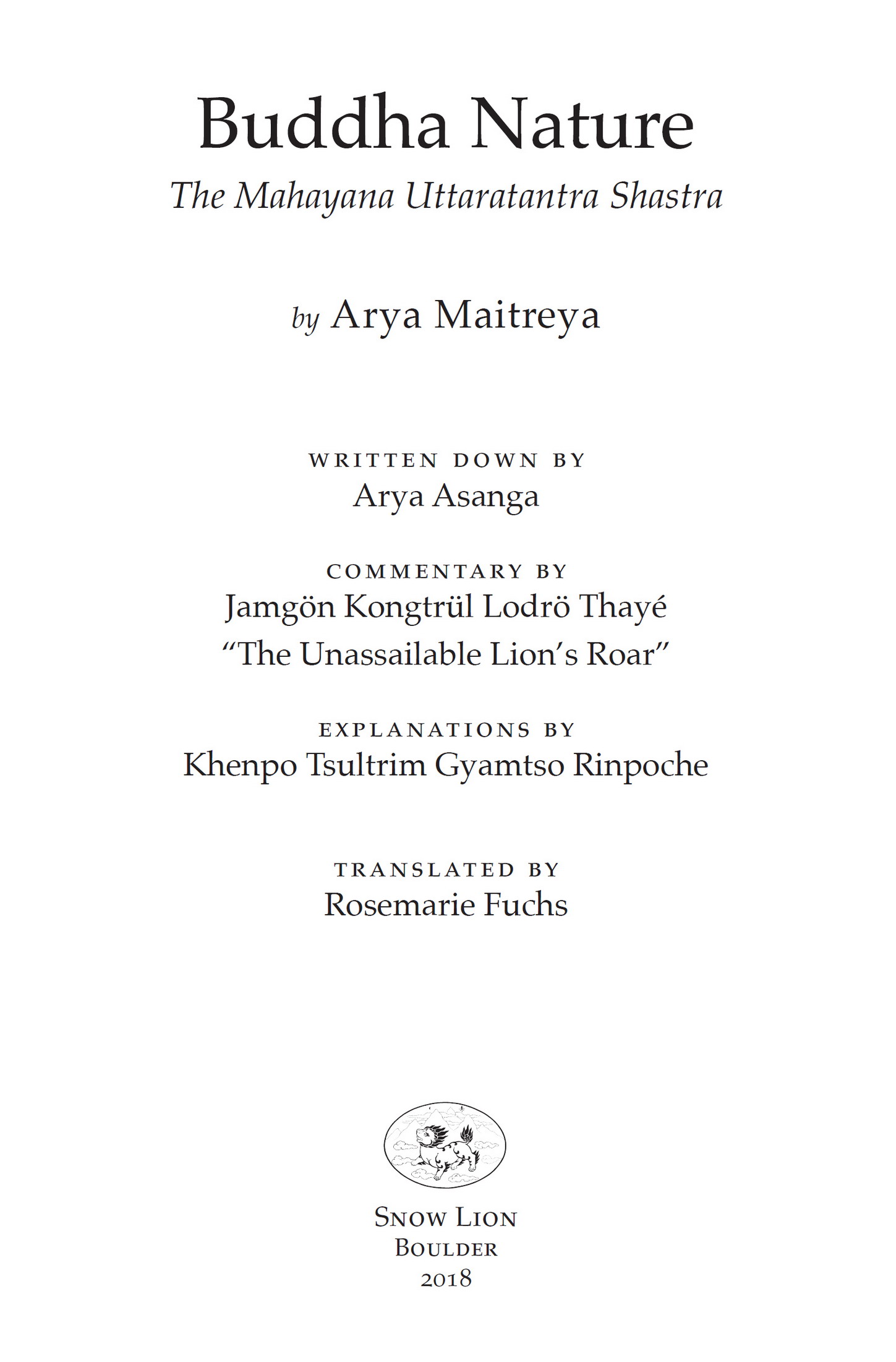Contents
Arya Maitreya
S NOW L ION
An imprint of Shambhala Publications, Inc.
4720 Walnut Street
Boulder, Colorado 80301
www.shambhala.com
2000 by Khenpo Tsultrim Gyamtso Rinpoche and Rosemarie Fuchs
Illustrations by R. D. Salga
All rights reserved. No part of this book may be reproduced in any form or by any means, electronic or mechanical, including photocopying, recording, or by any information storage and retrieval system, without permission in writing from the publisher.
Cover design: Gopa & Ted2, Inc.
T HE L IBRARY OF C ONGRESS CATALOGUES THE PREVIOUS EDITION OF THIS BOOK AS FOLLOWS :
Ratnagotravibhga. English. Buddha Nature:
the Mahayana Uttaratantra Shastra/by Arya Maitreya;
with commentary by Jamgn Kongtrl Lodr Thay,
The Unassailable Lions Roar, and explanations by
Khenpo Tsultrim Gyamtso Rinpoche; translated by Rosemarie Fuchs.
p. cm.
Includes bibliographical references.
ISBN 978-1-55939-128-3 (cloth)
ISBN 978-1-55939-482-6 (paperback)
eISBN 9780834841673
1. Yogcra (Buddhism) I. Ko-sprul Blo-gros-mtha-yas, 18131899.
II. Khenpo Tsultrim Gyamtso, 1934 III. Fuchs, Rosemarie, 1950 BQ3022.E5 F83 2000 294.385dc21
00-008017 CIP
v5.3.2
a
Contents
Dedicated to
Khenpo Tsultrim Gyamtso Rinpoche in deep gratitude and love
May your noble activity continue as long as there is anyone in need.
Namo Guru
As time goes by, with your blessing may time itself reveal itself as timeless.
In timeless time and endless space may truth be felt as it beholds its face.
May the lotus of compassion bloom, fostering all beings in time and space.
May all suffering and torment be ended and all Enlightened Ones come to rest.
Foreword
This book presents the commentary by Jamgn Kongtrl the Great, Lodr Thay, on Arya Maitreyas Mahayana Uttara Tantra Shastra (Tib. theg pa chen po rgyud bla mai bstan bcos). This is the first time an English translation of this commentary has been published. The book is the fruit of twenty years of study by Rosemarie Fuchs, a member of the Marpa Translation Committee and a devoted student of the very Venerable Khenpo Tsultrim Gyamtso Rinpoche.
This commentary has been taught by Khenpo Tsultrim Gyamtso Rinpoche to many Buddhist students around the world. In 1997, he taught it at the Rigpe Dorje winter program in Pullahari, Nepal, the main seat of His Eminence Jamgn Kongtrl Rinpoche. At the end of the teachings Khenpo Tsultrim Gyamtso Rinpoche gave the responsibility of finding ways to publish this commentary to the Jamgon Kongtrul Labrang, with his heartfelt wish that the activity of the Fourth Jamgn Kongtrl Rinpoche, Lodr Chkyi Nyima, would flourish auspiciously.
Khenpo Tsultrim Gyamtso Rinpoche has been the spiritual advisor of Pullahari since His Eminence the Third Jamgn Kongtrl passed away in April 1992, and has clearly fulfilled the Third Jamgn Kongtrls wish in establishing Pullahari as a place for the study and practice of Buddhadharma.
The Jamgon Kongtrul Labrang is profoundly grateful to Khenpo Tsultrim Gyamtso Rinpoche, Rosemarie Fuchs, and Snow Lion Publications for making this teaching available to students and practitioners today and in the future. May this book benefit countless beings through the proper understanding of the ultimate Buddhist view.
Tenzin Dorjee
General Secretary to H.E. Jamgn Kongtrl Rinpoche
Pullahari Monastery, Nepal
July 16, 1999, the auspicious day of the first turning of the Wheel of Dharma.
Preface
This is a translation of the Mahayana Uttara Tantra Shastra (root text by Arya Maitreya, written down by the noble Asanga, with commentary by the first Jamgn Kongtrl Rinpoche Lodr Thay) as explained by Khenpo Tsultrim Gyamtso Rinpoche in 1978 in La Poujade, France, and in 1979 in Brussels, Belgium. It is the first translation of this particular commentary into a Western language. Throughout Buddhist history, the words of the Buddha and the scriptures explaining their meaning were translated when they were imported into different cultures. Though the first translation was never a final or flawless one, it constituted a basis for better ones to come in the future. I hope that this present text may continue this tradition. As it has been created at the advice and under the guidance of a truly accomplished master, there should be some virtue in it, and I wish that it may be of utmost benefit to any reader.
The introduction to Jamgn Kongtrl Rinpoches commentary is not translated here, but can be found in S.K. Hookhams book The Buddha Within (Albany: State University of New York Press, 1991), pp. 263-288.
I would like to express my deep gratitude to Dzogchen Pnlop Rinpoche, Sangj Nyenpa Rinpoche, Ringu Tulku Rinpoche, Acharya Lama Tenpa Gyaltsen, the late Acharya Tenpa Gyaltsen Negi, and Burkhard Quessel for their kind and invaluable help in the translation of passages that I found myself unable to do on my own. My further thanks go to Ani Jinpa for kindly proofreading the root text, to Lama Alaisdar MacGeaugh, and to Alexander Wilding for his incessant willingness to share his knowledge of dharma, improve my command of English, and to eliminate my old-fashioned reluctance to use computers. Special heartfelt thanks are owed to Katia Holmes who translated Khen Rinpoches teachings on the root text in 1978 and thus made his instructions accessible for me and was my first teacher of his native language. Finally, I would like to thank Chris Hatchell for his careful and considerate help in editing the text.
The stanzas of the root text are presented in accordance with their explanation in the commentary. To stay as closely as possible to the original, the translation keeps the number of lines of the Tibetan text. As to the use of brackets, the content therein was added when it seemed necessary to facilitate understanding. In the case of the root text, these interpolations are derived from the commentary by Jamgn Kongtrl Lodr Thay; in the case of the commentary they are based on the explanations given by Khenpo Tsultrim Gyamtso Rinpoche.
One final point should be noted. Unlike Tibetan, the English language frequently requires the introduction of a pronoun, so a choice between he and she seemed necessary to avoid clumsiness. As buddha nature is neither male nor female, the term he, when used for a buddha or bodhisattva, should be understood as meaning he or she. Being a woman myself and convinced of the possibility of reaching enlightenment in female appearance, I thought it permissible to make this decision and hope it will not cause offense.
Rosemarie Fuchs
Hamburg, 23rd of July, 1999
Introduction
I.
The content of this volume is of the following essence: the teacher who explains the ground, path, and fruition of practice is the perfect Buddha, and from among all philosophies in the world his words are the highest and most genuine. The greatest commentary on their intention is the


